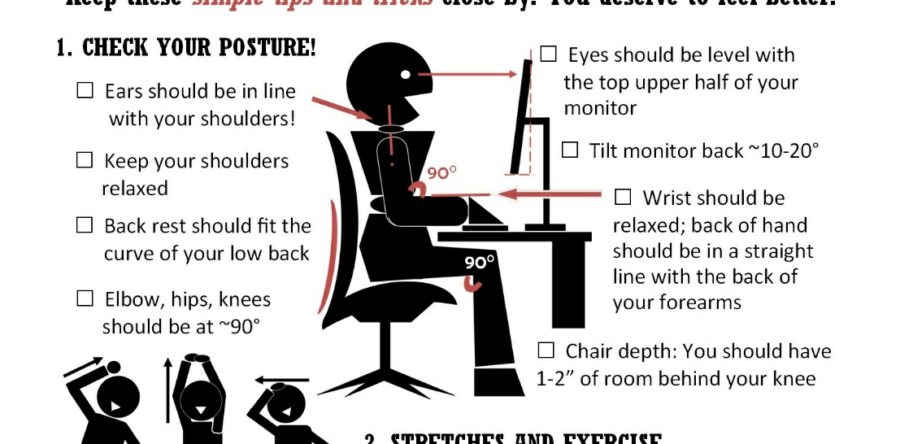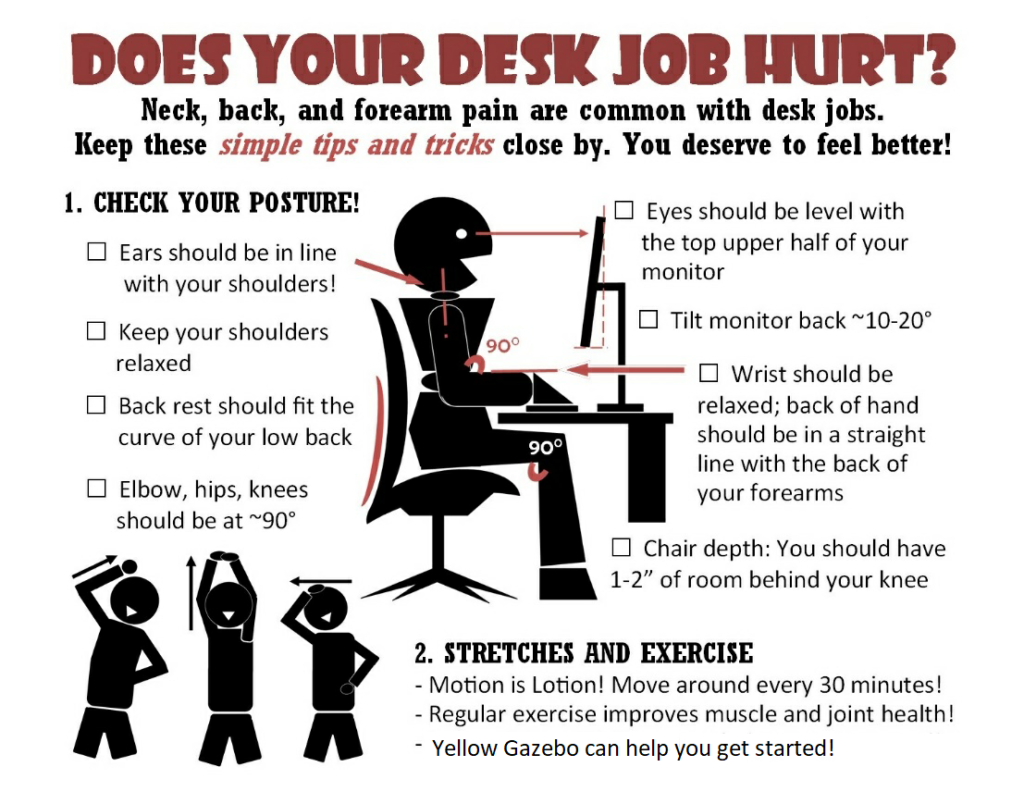Your Posture at Your Desk
Sitting at a desk can lead to chronic back, neck and forearm pain. There are several things that you can do that can help.
Below is a postcard you can print and keep by your desk. It will act as a reminder to keep checking your posture and to get up and move around.
Here is a bit more information on the points listed above:
- Set-up a good ergonomic workstation for yourself. The checklist reflects the ideal set-up of your workstation. You don’t necessarily need an expensive chair or desk to do this. You can use household items to help you achieve a better workstation. For example, put those old phone books to good use - use them to prop up your screen, or as a foot rest to achieve the ideal knee angle. If your chair is too deep, a firm pillow can help ensure you have enough room behind your knees while maintaining a good back support that will fit the curve of your back. For those who work on laptops, you will find that even if your posture is perfect, you will be looking down at your screen. The best thing to do in this case is to buy a keyboard and mouse so that you can prop up your laptop to the perfect height without compromising the position of your elbows and shoulders.
Now, a disclaimer. There is no such thing as the perfect position! Research has found that you can have the perfect workstation set up but if you don’t get up to move around at least twice per hour, you will still experience stiff muscles and joints. To make it clear, this doesn’t mean you can slouch over your desk and expect to be okay if you get up every 30 minutes. The best thing you can do for yourself is: maintain good posture while at your desk, but make a point of getting up every 30 minutes to stretch and walk around. Which leads us to…
- Motion is Lotion. I’m not telling you to get up and run a marathon every half hour or do 100 push-ups by your desk. All I want you to do is get up and off your chair and move around for about 30-60s before going back to you work. The motion can be as simple as moving your neck, shoulders and back in a circular motion, or marching on the spot, or walking over to the lunchroom and grabbing a drink of water. Less than a minute of movement twice every hour can help prevent a lot of issues down the road! Unfortunately, and I do understand this, it can be hard to remember to do this during a busy work day. However, I can guarantee that by the end of the day your body will thank you for remembering.
- Exercise. Regular moderate to high intensity exercise (3-4x/week) that incorporates weights and cardio can really make a difference on your health and energy level, but recent research shows that may not be enough. A 30 minute exercise routine done once a day does not mean you are free to sit all day. Sitting for long periods of time has been associated to higher risks of heart disease, diabetes and cancer, regardless of exercise. Those who exercised regularly had lower risk than those who did not engage in any physical activity at all, however the lowest risk was seen in those who not only exercised but also engaged in light activity throughout the day.
- Chiropractic care: Pain is often the last symptom you feel in posture related injuries. So it's a good idea to check in with your chiropractor every month to ensure it never gets there! They can assess your posture and give you stretches and exercises to counter the effects of your desk job. Treatment would also help in moving and improving function of joints to ensure proper blood and nerve flow to muscles! If you're already feeling pain from your job, don't worry! Chiropractors can help relieve that pain by identifying areas of stiffness and tension and relieving it through soft tissue work, mobilizations and adjustments- it might just take a few sessions but coupled with active care, they can help you feeling more like yourself in no time!
Dr. Belinda Chan has been with Yellow Gazebo since 2016










